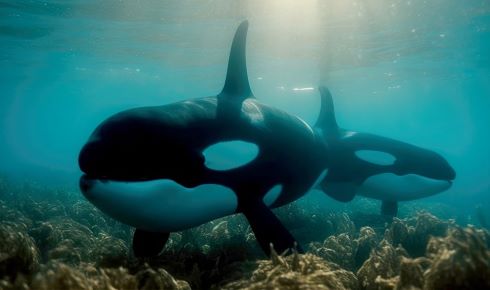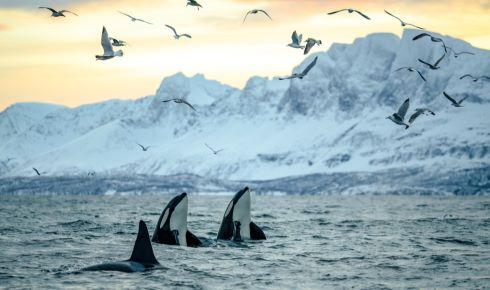Killer Cultures

December 11th 2023
Amid reports of orcas attacking boats off the coast of Spain and Portugal, Hanne Strager looks at the amazing variety of killer whale cultures, including a pod that famously helped, not harmed, seafarers
Over 100 years ago whalers in Australia’s Twofold Bay often found themselves roused from their slumber by the resounding lobtailing of killer whales (also known as orcas) in the waters near their whaling station. These short, thunderous tail slaps echoed like rifle shots through the stillness of the night. It was the orcas’ way of signalling that they had located prey – a large baleen whale somewhere in the bay.
The men at the whaling station would then spring into action, launching their boats to shadow the killer whales to their quarry. Upon catching up with the whale, typically a humpback or right whale, the killer whales would join the pursuit. Some would bite at its tail or fins, while others attempted daring leaps on to the whale’s back to obstruct its blowhole, depriving it of precious breath. Meanwhile, still more killer whales would assail its flanks or mouth and block its escape, herding it back toward the awaiting whalers and their harpoons.
Once these collaborative efforts led to the death of the baleen whale, the whalers would yield the carcass to their cetacean partners. Securing a buoy to the carcass for easy retrieval, they were well aware that the killer whales preferred the tongue and lips, leaving the remainder largely untouched. The whalers called it the law of the tongue. After the killer whales had had their fill, the whalers would return to transport the carcass to the whaling station, where they would meticulously extract the valuable blubber to be rendered into oil.
Much like modern day researchers who use ID photography to identify individual orcas, the whalers knew their cetacean helpers individually. They had names for them and used scars, nicks, marks and the shape of the dorsal fin to identify them.
This remarkable collaboration between whalers and killer whales was first documented in the mid-1840s, ultimately drawing to a close in the 1920s, when the large baleen whale populations had been decimated by years of industrial whaling. With the absence of baleen whales to hunt, the whalers reluctantly abandoned their trade, and the killer whales either departed the area or fell victim to whalers in other regions who perceived them as rivals over a dwindling resource.
Behavioural niches
All over the world killer whales have been characterised by having cultures, defined as sets of behaviours transmitted socially and passed down from generation to generation through social learning¹. Some killer whale communities exhibit distinct dietary preferences, with some specialising in hunting and eating other marine mammals, while others specialise in catching salmon or schooling fish. They can possess unique acoustic repertories specific to their groups. Some groups have a habit of frequenting what are known as ‘rubbing beaches’, where they gather to rub their bodies against the smooth pebbles at the bottom, while others don’t exhibit this behaviour. For the killer whales in Twofold Bay, hunting large baleen whales with the local whalers was part of their culture, and they passed the knowledge on to several generations of killer whales, just as the whalers did to their children.
 Killer whale culture is passed from generation to generation and between individuals
Killer whale culture is passed from generation to generation and between individuals
The maintenance of different cultures and traditions is one of many things that make killer whales so fascinating, However, it is also something that renders them vulnerable, because unique cultural traits can be lost if a small population faces extinction. Although killer whales are distributed globally, from freezing polar seas to the tropics, they are not numerous anywhere. Their populations are typically small, sometimes perilously so, with the risk of extinction looming. In many places what to the untrained eye looks like one strong population may be several separate, smaller and more vulnerable groups, known as ecotypes, because their dietary preferences place them in separate niches in the ecosystem. Some groups are well studied, such as those in the Pacific Northwest in North America and in Kamchatka in Russia, where fish-eating killer whales occur in the same waters as killer whales that eat marine mammals.
Distinct ecotypes
In the Pacific Northwest two more ecotypes live side by side. The so-called southern resident killer whales, a small, genetically isolated population of killer whales, eat salmon almost exclusively, whereas Bigg’s killer whales feast on marine mammals, primarily porpoises and seals. However, a recent study documented that the southern residents do attack and kill porpoises, but they never eat them. This behaviour is puzzling, especially as the southern resident killer whale population has been declining since 1995, dropping from almost 100 whales to only 73 in 2022. Their decline is linked to a decline in Chinook salmon, their preferred prey. It seems as if their preference for salmon is so strong that even with a lack of their preferred prey and other prey captured, they still don’t make the switch. Ultimately, the culture of these killer whales, with its strict dietary preference, may prevent this population from recovering from a decline that could end in extinction.
The various cultures and resulting ecotypes of killer whales are genetically distinct to such an extent that many of them can be easily distinguished visually due to their morphological characteristics. For instance, one ecotype found in sub-Antarctic waters is identifiable by its notably tiny white eye patch, short dorsal fin, bulbous head and small teeth compared with other killer whales. Another ecotype, inhabiting Antarctic waters, is smaller than other killer whales and has a forward-slanting eye patch and a dark grey dorsal cape, which is considerably larger than the typical grey saddle patch seen on all killer whales.
At least 10 killer whale ecotypes have been identified, but the actual number may be much higher, as many killer whale populations have not been studied sufficiently to determine these characteristics. The mounting evidence suggests that these diverse forms of killer whales, with differences in morphology, genetics, ecology and behaviour, may warrant subspecies designations and, in some cases, possibly even separate species classifications².
The boat rammers
Recently, a novel behaviour has been observed in killer whales around the Iberian Peninsula. Since 2020 killer whales in this area have wrecked more than 100 boats, sometimes ramming them with the full force of their six- to eight-tonne bodies, while other times they hit the rudder or bite it to pieces with their battery of 7cm-long teeth. In 2020 alone scientists in Portugal and Spain counted 52 so-called ‘interactions’ between boats and orcas. In 2022 it climbed to 207. Many boats have been so badly damaged that they require towing to the shore for repairs, and five were sunk.
Scientists use the word ‘interaction’ because they are unsure about the motives behind the unusual behaviour. In November 2022 French sailor Auguste Drion was on board the Smousse when it was rammed by a small group of killer whales. Drion and his fellow sailors said that initially they were not worried: it was a calm and sunny day, and they were convinced that the killer whales would eventually leave. However, after a while they heard a very loud crack and Drion rushed below deck to inspect the hull from the inside. Here he found water pouring in. By the time the skipper issued a mayday call, water was sloshing around their thighs. The crew was lucky, as a nearby vessel heard their distress call and rushed to pick them up. From their rescuers’ boat Drion and his crew witnessed their own vessel sinking below the surface.
Drion didn’t sense that the killer whales were being aggressive. His impression was that they were merely playing. It is entirely possible, perhaps even plausible, that the killer whales are doing this for fun – the whale equivalent of a gang of roving hooligans, vandalising just because they can.
Although it appears that the whales are learning this behaviour from each other, one of the criteria for a behaviour to be labelled as a cultural trait is that it has been going on for a while – it is currently much too short a time to say that it is part of the Iberian killer whales’ culture to vandalise boats. And hopefully it will vanish again, as behaviours that are not driven by an advantage to the animals frequently do.
Often the development of cultural traits arises as their specialisation increases their hunting efficiency. The more they hunt herring, or salmon, or seals, the better they get at capturing that specific prey. In the case of the killer whales in Twofold Bay, they cultivated their unique culture alongside human communities, reaping the advantages during the late 19th-century whaling boom. However, there is evidence suggesting that the special connection between killer whales and humans in this region goes back much further in history.
Brothers in arms
When the first European whalers arrived in Twofold Bay they encountered the Thawa people, the indigenous inhabitants of the area, who already held a profound bond with the whales. The Thawa people regarded orcas as their kin and referred to them as ‘beowas’. In their language ‘beowas’ translates to ‘kin’ or ‘brother’.
A unique bond had developed between the Thawa people and the killer whales in the bay. Perhaps this connection began when killer whales, in pursuit of marine mammals, would occasionally herd a whale nearer to the coast or even on to the beach, facilitating easier catches for the Thawa people. An early anthropologist of the continent described how Thawa people would light fires on the beach, sing and slap the water with sticks to attract killer whales and elicit them to drive larger whales on shore, creating a vast food resource for the community. The European whalers, who hired the Thawas to help on their whaling boats and were wise enough to listen to their advice, benefitted from this already established relationship³.
By the end of the 19th century there were gradually fewer and fewer big baleen whales to hunt and also fewer killer whales. Either the killer whales moved to places where there was more food to be found or they died out one by one. The whalers in Twofold Bay grew concerned and in 1906, for the first time in history – and the only time so far – whalers argued for the protection of a whale species4. Not for the humpback whales and right whales they were hunting, of course, but for their trusted allies, the killer whales. In 1978 the Australian government voted for the protection of all whale species, including killer whales. But the protection came much too late. By that time the killer whales of Twofold Bay had long disappeared – and their unique culture vanished with them.
Hanne Strager is a Danish biologist, whale researcher, and author of The Killer Whale Journals: Our Love and Fear of Orcas.
1) Whitehead, H. & Rendell, R. The Cultural Lives of Whales and Dolphins (University of Chicago Press, 2014).
2) Reeves, R. et al. Orcinus orca. The IUCN Red List of Threatened Species 2017, e.T15421A50368125.
3) Mathews, R. H. Ethnological notes on the Aboriginal tribes of New South Wales and Victoria. J. Proc. R. Soc. N. S. W. 38, 203–381 (1904).
4) ‘Protection for the “killer”.’ Daily Telegraph, 27 October 1906.


